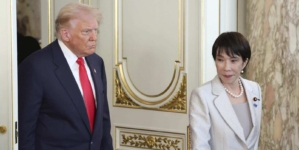-
Mapped: China’s Nuclear Counterstrike Missile Silos - 19 mins ago
-
Kimmel Tells U.K. Viewers ‘Tyranny Is Booming’ in America - 26 mins ago
-
How to Watch Nuggets vs Timberwolves: Live Stream NBA on Christmas, TV Channel - 54 mins ago
-
John Carey, Literary Eminence Who Excoriated Snobbery, Dies at 91 - about 1 hour ago
-
Japan Approves Record $58 Billion Defense Budget Amid Rising China Tensions - about 1 hour ago
-
Christmas Day shooting in Lancaster kills 16-year-old, injures 4 more - 2 hours ago
-
5 Key Moments in the Rise of India’s Hindu-First Powerhouse - 2 hours ago
-
NFL Reacts to Viral Postgame Handshake Between Travis Kelce and Bo Nix - 2 hours ago
-
The Hindu Right’s 100-Year Quest to Reshape India - 3 hours ago
-
Is Travis Kelce Retiring? Chiefs Legend Believes It Could Be the End - 3 hours ago
Trump administration accelerates its plan to shut down the Education Department
WASHINGTON — The Trump administration on Tuesday accelerated the dismantling of the U.S. Department of Education with a plan to transfer key, legally required functions to other agencies, including oversight of its $18-billion, core anti-poverty program, Title 1.
Critics said the move was politicized and counterproductive and fear future program cuts. California Supt. of Public Instruction Tony Thurmond said vital services to the state and nation’s most vulnerable students were likely to be disrupted.
The steps move toward fulfilling a Trump campaign promise to eliminate the department, which some conservatives have long derided as wasteful, ineffective and unnecessary.
“The Trump Administration is taking bold action to break up the federal education bureaucracy and return education to the states,” U.S. Secretary of Education Linda McMahon said in a statement. “Cutting through layers of red tape in Washington is one essential piece of our final mission.”
President Trump called for the department’s elimination in a March executive order. Both he and McMahon have spoken of a broad goal of sparking innovation through local control.
Even before this effort, states provided about 90% of their own funding for education, but federal investment is still crucial, advocates say. In particular, the federal role has focused on ensuring services are provided for overlooked students and students with higher needs, such as those facing discrimination and poverty, and students with disabilities.
While slashing the Education Department workforce, which Trump officials have characterized as a bloated bureaucracy, the president has adopted an interventionist agenda in education as well. He has threatened pulling federal funding if states and schools don’t follow his directives to combat antisemitism, clamp down on campus protests, end diversity, equity and inclusion programs and oppose expanded rights for transsexual students, among other issues in keeping with his agenda.
The strategy behind the moves
The key strategy announced Tuesday creates partnerships with other federal agencies, which will take on Education Department responsibilities. The department would retain legal authority even as the actual work shifts elsewhere.
These partnerships are meant to sidestep federal rules — under the jurisdiction of Congress — that place programs, including Title I, specifically within the Education Department.
Title I is expected to shift to the Department of Labor, which is likely to absorb an unknown number of education workers with the necessary experience and expertise. The long-term goal is to win buy-in from Congress — and then to eliminate the Education Department entirely, which requires congressional approval.
“As we partner with these agencies to improve federal programs, we will continue to gather best practices in each state,” McMahon said.
She also spoke of working “with Congress to codify these reforms,” an acknowledgment that the Department of Education was created by an act of Congress.
Administration officials insist that their actions to date are legal, citing as precedent earlier agreements between federal agencies, including one example from the Biden administration. The scale of the current effort, however, is a much larger order of magnitude.
Rep. Jimmy Gomez (D-Los Angeles) questioned Trump’s authority to take this action. “Not only is dismantling the education department without congressional approval illegal, but they chose today because they knew the Epstein vote would dominate the headlines. They clearly didn’t want the public to see what they were doing to our kids’ futures.”
Becky Pringle, president of the National Education Assn., the nation’s largest teachers union, accused the administration of “taking every chance it can to hack away at the very protections and services our students need.”
How the action affects vulnerable students
The changes will complicate efforts to get money and services where they are needed, Thurmond said.
“This is an unnecessary, disruptive change that is going to harm students, especially the most vulnerable,” Thurmond said. “It is clearly less efficient for state departments of education and local school districts to work with four different federal agencies instead of one.
“Experience also tells us that any time you move expertise and responsibilities, you disrupt services. There is no way to avoid negative impacts on our children and our classrooms with a change of this magnitude.”
But administration officials talked of new efficiencies and synergies, asserting that associating education with workforce development in the Department of Labor would make education more relevant to a student’s employment future.
What happens to other programs?
The Labor Department would oversee almost all grant programs that are now managed by the Education Department’s offices for K-12 and higher education. That includes funding pools for teacher training, English instruction and TRIO, a program that helps steer low-income students to college degrees.
Tuesday’s action leaves in place the Education Department’s $1.6-trillion student loan portfolio and its funding for students with disabilities.
But ultimately moving these programs seems likely if the mission remains to shutter the department.
Another transfer puts Health and Human Services in charge of a grant program for parents who are attending college, along with management of foreign medical school accreditation. The State Department will take on foreign language programs. Interior will oversee programs for Native American education.
Federal officials said states and schools should see no funding disruptions. Liz Huston, White House assistant press secretary, said Tuesday the administration “is fully committed to doing what’s best for American students, which is why it’s critical to shrink this bloated federal education bureaucracy while still ensuring efficient delivery of funds and essential programs.”
The Education Department tested this approach in June, announcing the transfer of adult education programs to the Labor Department. Working out essential details took some five months, officials said Tuesday.
The administration’s plan immediately drew support from Tim Walberg, a Republican who represents a southern Michigan district.
“The past few decades have made one thing clear: The status quo is broken,” Walberg said. “As the bureaucracy swelled, left-wing bureaucrats were emboldened to waste taxpayer dollars on a radical agenda. As a result, our students have been left in the dust. Test scores are plummeting, students can’t read, and college graduates leave school burdened by debt rather than equipped with workforce-ready skills.”
But the Education Department — and its central programs — has bipartisan support.
One Republican expressing concern is Pennsylvania Rep. Brian Fitzpatrick.
“The United States Congress created the U.S. Department of Education for very good reason,” Fitzpatrick said. “And for millions of families, particularly those raising children with disabilities or living in low-income communities, the Department’s core offices are not discretionary functions. They are foundational. They safeguard civil rights, expand opportunity, and ensure that every child, in every community, has the chance to learn, grow, and succeed on equal footing.”
Feds say programs’ funding will continue
Department officials said programs will continue to be funded at levels set by Congress. But that doesn’t stop programs from running afoul of another portion of the Trump agenda. For example, the Tuesday announcement notes that a program to help with the education of the children of migrant workers will transfer to the Labor Department.
However, on other fronts the Trump administration is trying to eliminate that program. The administration first tried to hold back funding approved by Congress. The administration relented under pressure. But the administration also cut funding for migrant education from its budget proposal for future years.
Officials said they did not yet have details on whether the changes would bring further job cuts at the Education Department, which has been thinned by waves of layoffs and retirements under pressure.
Blume is a Times staff writer. Binkley writes for the Associated Press. Times staff writers Daniel Miller and Michael Wilner contributed to this report.
Source link


















